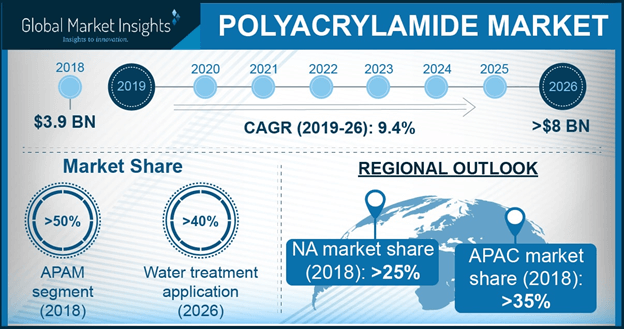APAC Polyacrylamide Market to record highest growth over 2017-2024, water treatment applications to drive the regional demand
Publisher : Fractovia | Published Date : July 2017Request Sample
Treatment of waste water and sewage is closely linked with environmental sustainability, the prime factor stimulating polyacrylamide market dynamics lately. Over the past few years, there has been a substantial increase in industrial and municipal effluents including heavy metals, synthetic surfactants, organic compounds, and other pollutants, subject to the rapid industrialization of the developing and developed nations. In a bid to respond to this detrimental environmental call, global wastewater treatment industry is gaining a renewed attention, leaving a subsequent impact on polyacrylamide market demand. With regards to water treatment application, polyacrylamide industry is expected to grow at an annual rate of 8% over the coming seven years.
Swift depletion of natural energy resources along with strong consumer awareness across APAC belt has resulted in the installation of a large number of wastewater treatment units, especially in the industrial and municipal sectors. The petroleum industry is also readily adopting polyacrylamide for the recovery of crude oil that is beneath the earth surface. The increasing energy demand across myriad end use domains including transportation, domestic, power sector, etc., have significantly increased the exploration and production activities of this crude oil, which in a way has opened lucrative business opportunities for polyacrylamide industry. As per estimates, the polyacrylamide market size from petroleum application is likely to record an upstream with 8.5% CAGR over 2017-2024.
U.S. polyacrylamide market size, by application, 2013 - 2024 (USD Million)

Global polyacrylamide industry involves the participation of top players such as Kemira Oyj, Mitsubishi Rayon, BASF, PetroChina Company, Xitao Polymer, Ashland, and Beijing Hengju Chemical Group. Product innovation and strategic partnership have become popular tactics characterizing the growth spectrum of the market. In 2016, the business landscape was highly concentrated with leading companies representing 40% of the overall share. Most firms are focusing on expanding the production facilities to exploit the emerging markets. The recent investment of USD 5 million by Solenis, the specialty chemicals giant, in its manufacturing unit in Russia, is an evidence of how market players are ingrained in extending their geographical presence. In this regard, it is prudent to note that Asia Pacific currently holds a strong position in the global polyacrylamide industry with regards to production facilities.
Having said that, a market analysis report by Global Market Insights, Inc., asserts APAC polyacrylamide market will experience maximum growth in the coming seven years, with a projected CAGR of 8% over 2017-2024. Comprising of some of the most developing countries like China, India, Malaysia, this belt is more prone to the harmful effects of industrialization and urbanization. This strong backdrop along with the stressing need for conserving the natural resources is upscaling polyacrylamide market demand in APAC belt.
A major chunk of the product landscape of polyacrylamide market is procured by anionic polyacrylamide. Given the product’s extensive utilization in waste water treatment, paper making additives, and oil recovery, anionic polyacrylamide accounted for the maximum share of the overall industry in 2016. Industrial waste water from metal industry, steel plant is coarse, concentrated, and alkaline in nature, and are are best treated with this category of polyacrylamide. Furthermore, anionic derivatives are also gaining a traction in the energy sector where crude oil drilling process is prevalent. As per reliable statistics, anionic polyacrylamide market will witness a steady gain of 7% CAGR over 2017-2024. Nonionic polyacrylamide market will also witness an appreciable growth over the forecast span, with an expected CAG of 8.5%, driven by their wide usage in treatment of acidic waste water which comes as a common effluent from food processing, mining & coal, and paper making industries.
Considering the geographical trends, North America has proved to be another outpacing region actively partaking in the global polyacrylamide market. The regional market, in 2016, held a valuation of USD 1 billion. In this respect, shale oil boom, particularly in the U.S., has immensely influenced the market dynamics. In addition, mandatory roll outs formulated by EPA regarding energy sustainability and security are also providing a significant impetus to the regional polyacrylamide industry share.
The fluctuating raw materials price trends along with growing trend of bio based products is likely to deter the growth of polyacrylamide market. In addition to this, the proclamation of WHO regarding the carcinogenicity of acrylamide is anticipated to bring stumbling obstacles for polyacrylamide market as well. Nevertheless, efforts are being continuously undertaken by product manufacturers to combat these challenges. According to estimates, Global polyacrylamide industry is projected to hold a massive valuation of USD 10.7 billion by 2024, with a CAGR estimation of 8.5% over 2017-2024.